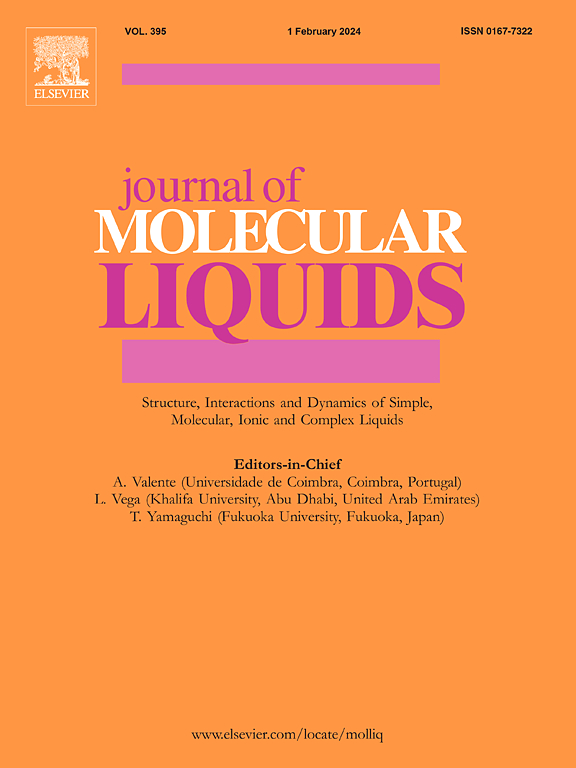Graphene oxide-assisted synthesis of N, S co-doped carbon quantum dots and surface polymerization as a thermosensitive nanocarrier for near-infrared light-triggered letrozole delivery
IF 5.3
2区 化学
Q2 CHEMISTRY, PHYSICAL
引用次数: 0
Abstract
Breast cancer treatment greatly benefits from targeted drug delivery systems, which increase therapeutic accuracy, reduce harm to healthy tissues, and enhance patient outcomes by delivering medications directly to the tumor site. A thermosensitive carrier was developed for letrozole (LTZ) delivery through free radical polymerization between N-vinylcaprolactam and allyl alcohol after graphene oxide-assisted nitrogen and sulfur co-doping of carbon quantum dots synthesis. The nanocomposite was characterized using various techniques. LTZ adsorption optimization was performed using response surface methodology (RSM) based on a central composite design (CCD). The performance of the RSM-CCD model was evaluated by examining the correlation coefficient along with several statistical error metrics, including root mean square error, average relative error, hybrid fractional error function, and Chi-square tests. The optimal drug adsorption conditions were determined through CCD analysis to reach a maximum efficiency of 87.92 % at pH 5, over a contact time of 30 min, with a temperature of 25 °C, using a drug solution concentration of 20 μg mL−1. The adsorption isotherm data showed the best fit with the Langmuir model, and the kinetic analysis confirmed agreement with the pseudo-second-order model. The developed thermosensitive nanocarrier has shown exceptional drug release efficiency, achieving 71 % release at 45 °C (pH 7.4), closely following the zero-order kinetic model (R2 = 0.9960). Under near-infrared laser irradiation, the nanocarrier showed remarkable photothermal properties, significantly enhancing drug release by approximately 90 % within 15 min. This innovative nanocarrier combines thermosensitive and photothermal capabilities, offering a promising approach for controlled and targeted drug delivery in biomedical applications.
氧化石墨烯辅助合成N, S共掺杂碳量子点及其表面聚合作为近红外光触发来曲唑递送的热敏纳米载体
靶向给药系统大大提高了治疗的准确性,减少了对健康组织的伤害,并通过将药物直接输送到肿瘤部位来提高患者的治疗效果。在氧化石墨烯辅助氮硫共掺杂碳量子点合成后,通过n -乙烯基己内酰胺和烯丙醇之间的自由基聚合,制备了一种热敏载体来曲唑(LTZ)。利用各种技术对纳米复合材料进行了表征。采用基于中心复合设计(CCD)的响应面法(RSM)对LTZ吸附进行优化。通过检验相关系数以及几种统计误差指标(包括均方根误差、平均相对误差、混合分数误差函数和卡方检验)来评估RSM-CCD模型的性能。通过CCD分析确定了最佳的药物吸附条件,在pH为5、温度为25℃、接触时间为30 min、药物溶液浓度为20 μg mL−1的条件下,吸附效率达到87.92%。吸附等温线数据与Langmuir模型拟合最好,动力学分析与拟二阶模型吻合。该热敏纳米载体在45°C (pH 7.4)下的释药效率达到71%,符合零级动力学模型(R2 = 0.9960)。在近红外激光照射下,纳米载体表现出显著的光热特性,在15分钟内显着提高了约90%的药物释放。这种创新的纳米载体结合了热敏和光热能力,为生物医学应用中的受控和靶向药物递送提供了一种有前途的方法。
本文章由计算机程序翻译,如有差异,请以英文原文为准。
求助全文
约1分钟内获得全文
求助全文
来源期刊

Journal of Molecular Liquids
化学-物理:原子、分子和化学物理
CiteScore
10.30
自引率
16.70%
发文量
2597
审稿时长
78 days
期刊介绍:
The journal includes papers in the following areas:
– Simple organic liquids and mixtures
– Ionic liquids
– Surfactant solutions (including micelles and vesicles) and liquid interfaces
– Colloidal solutions and nanoparticles
– Thermotropic and lyotropic liquid crystals
– Ferrofluids
– Water, aqueous solutions and other hydrogen-bonded liquids
– Lubricants, polymer solutions and melts
– Molten metals and salts
– Phase transitions and critical phenomena in liquids and confined fluids
– Self assembly in complex liquids.– Biomolecules in solution
The emphasis is on the molecular (or microscopic) understanding of particular liquids or liquid systems, especially concerning structure, dynamics and intermolecular forces. The experimental techniques used may include:
– Conventional spectroscopy (mid-IR and far-IR, Raman, NMR, etc.)
– Non-linear optics and time resolved spectroscopy (psec, fsec, asec, ISRS, etc.)
– Light scattering (Rayleigh, Brillouin, PCS, etc.)
– Dielectric relaxation
– X-ray and neutron scattering and diffraction.
Experimental studies, computer simulations (MD or MC) and analytical theory will be considered for publication; papers just reporting experimental results that do not contribute to the understanding of the fundamentals of molecular and ionic liquids will not be accepted. Only papers of a non-routine nature and advancing the field will be considered for publication.
 求助内容:
求助内容: 应助结果提醒方式:
应助结果提醒方式:


